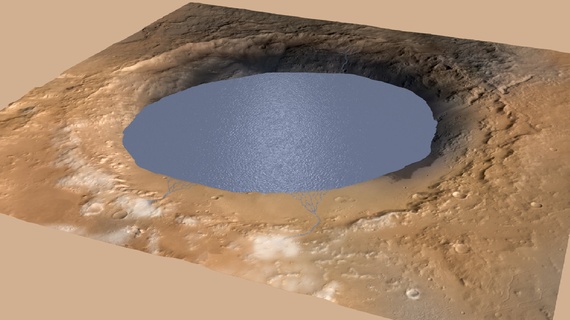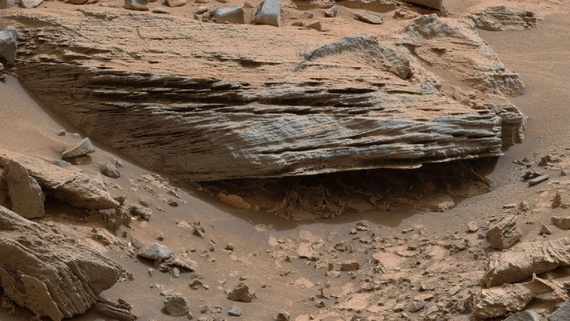The Evolving Search for Life on Mars

A self-portrait of NASA's Mars rover Curiosity. NASA
Before the first spaceflight, humanity’s sense of what—or who—might be in our galactic neighborhood was, by today’s standards, remarkably optimistic.
Martians terrified me growing up. I remember watching the 1996 movie Mars Attacks! and fearing that the Red Planet harbored hostile alien neighbors. Though I was only 6 at the time, I was convinced life on Mars meant little green men wielding vaporizer guns. There was a time, not so long ago, when such an assumption about Mars wouldn’t have seemed so far-fetched.
Like a child watching a scary movie, people freaked out after listening to “The War of the Worlds,” the now-infamous 1938 radio drama that many listeners believed was a real report about an invading Martian army. Before humans left Earth, humanity’s sense of what—or who—might be in our galactic neighborhood was, by today’s standards, remarkably optimistic.
A century ago, many people believed that Mars was filled with alien life, a notion that stemmed in part from a 1908 book called Mars as the abode of life by Percivial Lowell. Tales of an Earth-like Mars enthralled the public at the time and set the stage for mass hysteria following "The War of The Worlds" announcement. But ideas about Mars as home to an intelligent civilization began to fade in the 1960s when a Space-Race-era America sent Mariner 4, 6, and 7 on a flyby past the Red Planet. (Mariner 5 was built as a backup spacecraft but never used.) The probes beamed back images of a barren, moon-like Mars quite dissimilar to Earth.
The hope for Martians basically evaporated in 1976 when Viking 1 failed to find organic chemicals in the planet’s soil samples, according to Peter Ward’s 2007 book, Life as We Do Not Know It . From then on, expectations about Mars had shifted away from Martians and, instead, toward what scientists had long searched for: clues that the planet was once warmer, wetter, and capable of supporting life.
In the past four decades since the Viking missions, NASA conducted three Mars rover missions. The latest of those installments, Curiosity, has explored Mars’s Gale Crater, a 96-mile-wide barren bowl on the planet’s surface. That crater may have once been a lake, according to an announcement by NASA this month. The findings come from an analysis of rocks at the bottom of a mountain in the middle of Gale Crater called Mount Sharp. The alternating sediment layers at the base of the mountain show that water flowed at different levels over the course of millions of years.

Standing water, like what this finding suggests, is one of a few key ingredients needed for life. NASA scientists are also on the search for other ingredients including the chemical compounds carbon, oxygen, hydrogen, phosphorus, and nitrogen. With its latest discovery, the Mars Curiosity rover may have found a potentially suitable water source to support life. “This was a complete surprise,” Caltech geologist John Grotzinger told The Los Angeles Times . “There was no way to have recognized this from orbit.”
The Curiosity project scientist Ashwin Vasavada told the BBC that the findings may suggest that Gale Crater was once covered by a large ocean, which would have prevented the water from evaporating for millions of years. Curiosity has made prior findings hinting at life on the Red Planet, but as of yet, it has not found evidence of organic compounds on Mars. That may change as soon tomorrow, The New York Times reports , because NASA scientists plan to announce what they’ve discovered about organic compounds on Mars at the annual American Geophysics Union Conference in San Francisco.
“Our original interpretation—that there was a good chance the organics we were seeing are Martian—hasn’t changed,” Daniel Glavin of Goddard Spaceflight Center said to The Times . That information, combined with the recent findings from the European Rosetta mission comet of water unlike what is found on Earth, may help scientists better understand whether life has existed elsewhere in space.
All this hints at the way humanity's relationship with the rest of the universe has become ever more refined. Our expectations about what might be out there are far more nuanced than they were half a century ago. And instead of exploring space alone, an astonishing feat, we're now able to reach through time and begin to understand what might have been.

NEXT STORY: An Astronaut's View of Earth





